Vellinezhi: a Palakkad village that basks in the charm of a glorious past

Mail This Article
There is an indefinable otherworldliness about Vellinezhi, a hamlet on the banks of the Kunthipuzha in Palakkad, where purity sublimates with the spiritual. This village where the revered Olappamanna Mana stands can only be described as the ancestral home (tharavad) of Kathakali, where the classical dance form has left a rich legacy.
A trip to Vellinezhi is a pilgrimage, so pure is the aura around this cultural village and its men who have given their all to the art forms they so loved. Neither fame nor fortune could lure them out of the hallowed precincts of their theatre of art for which a large number of artistes sacrificed their entire lives and where life once reverberated to the beats of art forms like Koodiyattom, Ottanthullal, Krishnanattam, Tholpavakuthu, and Pulluvan pattu, to name just a few.
The stage and the shows still go on, but the number of audience has thinned significantly. There are no takers for the pure art form of Kathakali. But for this sad reality, the place is as it was centuries ago, rich in art, tradition and a way of life that can only be termed pristine.
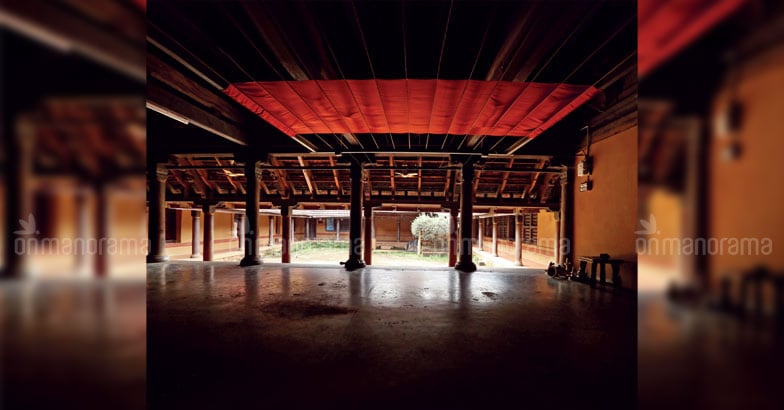
Talk about the Adakkaputhur mirror and the 'kalluvazhi chittakal' (principles of performance) and you are in the heart of history trying to relive traditions of the 'guru-shishya parampara' (lineage of teacher-disciple), which Vellinezhi resonated with once.
Manorama Traveller’s trip down history in this village opens up memories of a world where the best art forms of Kerala were performed.
Kelikottu
Those who love Kathakali would surely be familiar with the rigours of 'kalluvazhi chitta'. Kalamandalam Ramankutty Nair has in his autobiography narrated the gruelling physical regimen involved in the chitta (rules).
Not every student could endure the system. If he erred in his mudras, the guru’s hands would come down on his back can, the pain of which only the toughest could bear.
Pattikamthodi Ravunni Menon is Vellinezhi’s Kathakali maestro. Keezpadom Kumaran Nair, Ramankutty Nair and all the other Kathakali exponents are Pattikamthodi’s students.
The pilgrimage begins from Pattikamthodi’s home. It’s a tapestry of art, life, culture and history wherever one turns to in Vellinezhi. Today, all that Pattikamthodi Asan (master) has are his memories. He does not even have a roof above him, says Dr Achuthankutty, a native, for whom the world begins and ends with Vellinezhi - how else could one explain the psyche of a man who without any qualms threw away a career as researcher in Bhabha Atomic Centre in Mumbai for the charm of his native Vellinezhi?

Padma Shri Keezpadom
Keezhpadom Kumaran Nair was an income tax paying Kathakali artiste 65 years ago. Wherever there was a performance, Keezhpadom would be performing or he would be present. The evergreen MGR was a close friend of the maestro.
Keezhpadom’s son Unni remembers that it was his father who taught MGR to take his first steps in dance. And the superhero used to stay with them. The humble abode stays as it was. Gone is its glory. There was a time when the place was brimming over with life and performances.
Nobody can picture what it was like, nor will they ever understand, says Unni.
The way then winds up to the residence of Padma Shri Vazhenkada Kunju Nair, artiste par excellence. It’s Kunju Nair’s son Vazhenkada Vijayan Nair who lives there now. Uncompromising in his sense of discipline, Kathakali asan Vijayan Nair is known for his iron-fisted adherence to age-old principles and system.
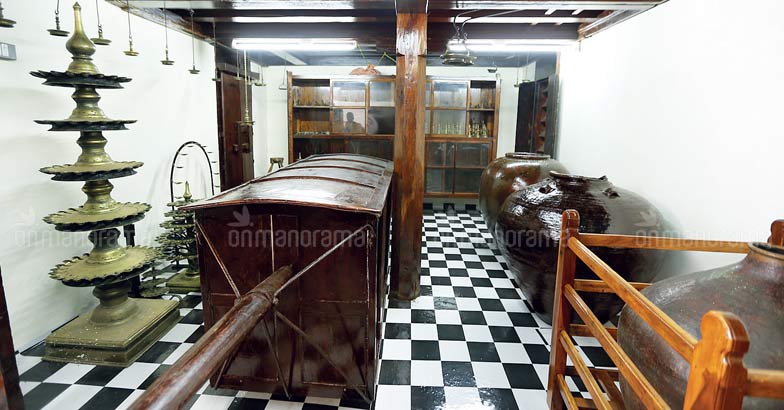
“I’m what I inherited from my father… all this fame, all these accolades. I got them because I was Kunju Nair’s son,” says the maestro.
“You cannot dilute the purity of Kathakali by slyly adding anything to it,” says the asan (master). He has never given a thought to fame, or even entertained a sense of loss. The innumerable awards and accolades, including the Padma Shri have left him untouched, so tightly wrapped is he in his cloak of humility.
Kalagramam
It’s just close to a year since the Central Government honoured Vellinezhi by conferring on it the status of Kalagramam (village of arts). Though the news was received with much fanfare and the place hogged the headlines for a time, visitors and tourists are in no way aware of the great heritage of the village… its legacy of art, its mesmerizing Adakkaputhur metal mirror, the Buddha Caves in Kuruvattoor and the majestic Olappamanna Mana. Nor has a thought has been spared to figure out where the Kathakali outfits and other accoutrements are readied.
There’s much more to be seen and savoured of Vellinezhi
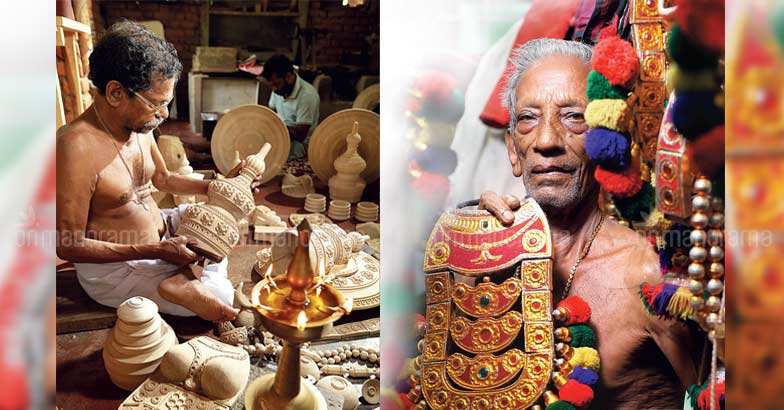
Bhranthankallu, the 'kolamaram' of Panamkunnu, Ashtapathi, Ezhammuthi, Onapattu, Kalamezhuthupattu, kalapoottu, Kolamkali, Kaikottikali, Chakyarkoothu, Cherumakkali, Tholpavakoothu, Nandhunipattu, Nayadikali, Padakalithallu, Parichamuttukali, Paana, Pankali, Pamputhullal and Poothanum Thirayum are what’s on offer here. The list is endless.
A canvas
Vellinezhi is easily a landscape artist’s canvas. The old world feel is brought on by the presence of a few stationary goods shops and a couple of tea shops. Looks like time has stood still here. The land is covered by rubber trees and sprawling compounds thick with wild, overgrown greenery. There are houses, old ones, in isolation in the middle of four to five acres of land with almost all the dwellings covered with roof tiles. The men are clad in mundu and long shirts with sandalwood paste drawn brightly on their foreheads. The womenfolk look demure in their saris and bindi's of sacred ash. The setting is totally rustic, with sprawling paddy fields on one side blending with the grace of the men and women working in the fields.
You have to take the mud road along the paddy fields to reach the workshop of chutti artistes Kalanilayam Rajiv and Padmanabhan, which stands at the end of the paddy fields. They are the artistes who make the Kathakali ornaments (Kathakali koppukal).
The crown, the bangle, hasthakadakam (hand ornaments), tholputtu (epaulette-like upper arm ornaments, paruthikkamani (three strands of beads tied below the tholputtu, kazhutharam (gold strand beaded necklace) and several other ornaments are crafted in this workshop.
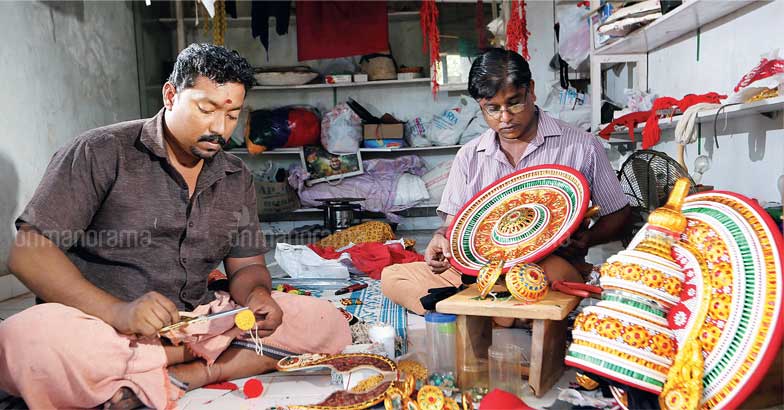
“It takes more than one and a half months to get the dress for the male character ready. The task is tedious. The moulds are made, coloured and given intricate and elaborate designs, all based on minute specifications. Beads are stitched on to the costume. There are ornaments which have to be pasted. It’s the crown that takes the longest to be readied, the polishing has to be perfect,” says Rajiv. Both the artistes are a regular feature at Kathakali stages where they ready the artistes for performance.
Kothavin Ramankutty Achary: He’s the artiste who carves out ornaments from wood. You will usually find him at his workshop surrounded by a large collection of ornaments and other trappings.
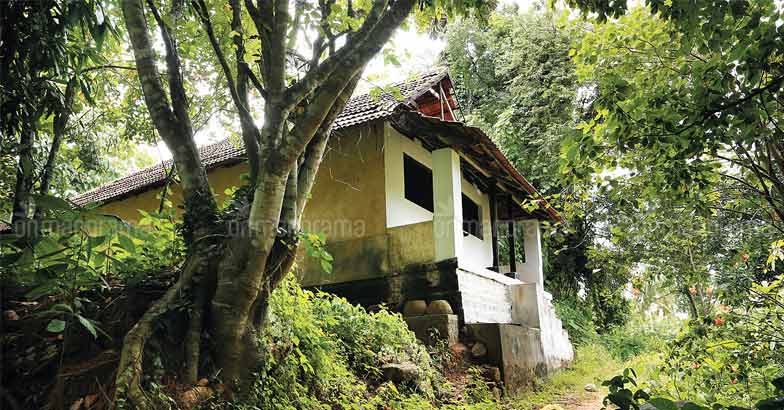
Kathakali is his life. “The crown or the headgear is what differentiates each character from the other. There are four types of crowns - aadhyavasanam, idatharam, kuttichamaram and kuttitharam. It takes more than a month to get the aadyavasana crown ready and three months to get the whole ensemble in top form. Going by the price of wood today, the cost of ornaments for one single character would run up to more than Rs 70,000,” says Ramankutty Achary.
The 69-year-old artiste’s devotion to Kathakali began at the age of 12 when he started crafting ornaments out of wood under the guidance of his father Krishnan Achary, who was one of Vellinezhi’s most sought-after woodwork artisans.
Ramankutty has not let his father Krishnan, who used to craft exquisite hasthakadakams, down.
Olappamanna Mana
Vellinezhi has a historic link with Buddhism, says Achuthankutty. The Kuruvattoor caves are proof of this, he claims. Ever since the discovery was made and the Archaeological Department inspected the place, the owners of the site fear that if the place is indeed of historical importance, it could be taken over by the government.
Of all the memorable sights in Vellinezhi, the most splendours is the Olappamanna Mana. A symbol of artistic purity, the sprawling architecturally grand old mansion with its 'ettukettu' (house with eight halls with two central courtyards) and malika pura was once the undisputed abode of Kathakali. Those revered men of letters who carried their scholarship, literature and arts to Valluvanad were all from Olappamanna Mana.
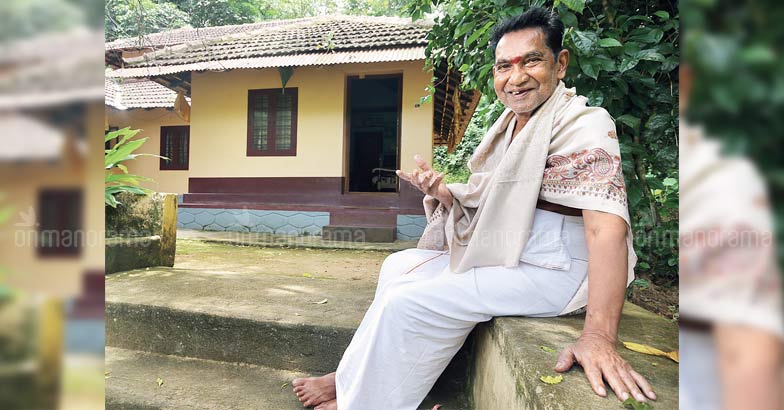
O. M. C. Narayanan Namboothiripad, the Vedic scholar who translated the Rig Veda to Malayalam, Neelakanatan Namboothiripad, who converted Olappamanna Mana into a centre of vedic scholarship and the great poet Olappamanna were but a handful of souls under whose blessings and tutelage great artistes were born. Though they have all faded into eternity, they have left their inedible footprints on the sands of Vellinezhi. It’s no exaggeration that the spirits of these great men still haunt the corridors of the mana.
The tour team was allowed to go round the mana. Part of the mana has been let out as a homestay for visitors.
“The office is open from 10 am to 1 pm. Whoever likes to see the mana are welcome during this period. But people hardly ever bother to check the time,” says manager Sankaranarayan Vadakkini. The mana is at present owned and maintained by Deviprasadam, a 20-member trust.
The mana has also been home to quite a few Malayalam movies, certain parts of which were shot here. Akashaganga, Araam Thampuran and Ennu Ninte Moideen all featured the this mana.
Building another such perfect ettukettu with its large courtyard, magnificent oottupura and innumerable bedrooms would be as good as a dream. Every bit of the mana, its doors, windows, ara-nira, utensils and other artefacts are a sight to behold.
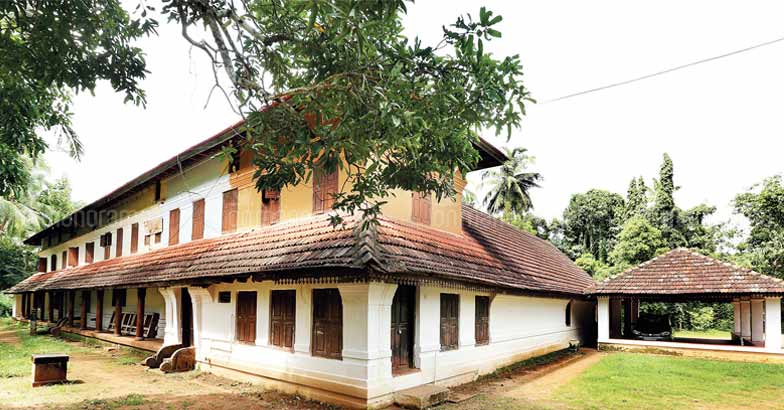
Kathakali acharyan Pattikamthodi Ravunni Menon’s crown is well preserved here. The mana also has a large collection of centuries-old wooden utensils, a palanquin and wooden almirahs.
Olappamanna’s library, chair and a few other personal belongings too have been kept well. The main attraction of the first floor is the room where the original script of the Rig Veda in Malayalam has been preserved.
Among the many hallowed guests who were privileged enough to stay here was Carnatic music maestro Chembai Vidyanatha Bhagavathar who used to frequent the mana. He was given the room adjoining Pattikamthodi Asan’s, a gesture reserved only for the creme de la creme.
Olappamanna Mana is part of Vellinezhi’s tradition, its life, art and culture, says the manager.
Adakkaputhur metal mirror
If Aranmula has its kannadi (mirror), Vellinezhi too has its exquisite mirror to boast of, only that it’s born to blush unseen. Without any publicity, not even a word of mouth push, the fame and merit of the Adakkaputhur metal mirror remains unknown.
“The first step is to make a mould with a mix of clay, bronze and rice husk into which white molten lead is poured. When this solidifies, the clay is broken and the first shape of the mirror emerges. This is then polished till it shines and beautifully reflects the glory of one’s face on it. The mirror is then fixed on to a brass frame,” says Krishnakumar, Balan Mooshari’s son, explaining the intricacies involved in making the mirror. It was Balan Mooshari who made and polished the first 'vaalkannadi'. Krishnakumar refined and perfected the craft by melting steel and tin to cast ornate frames in golden hues which could hold the mirror.
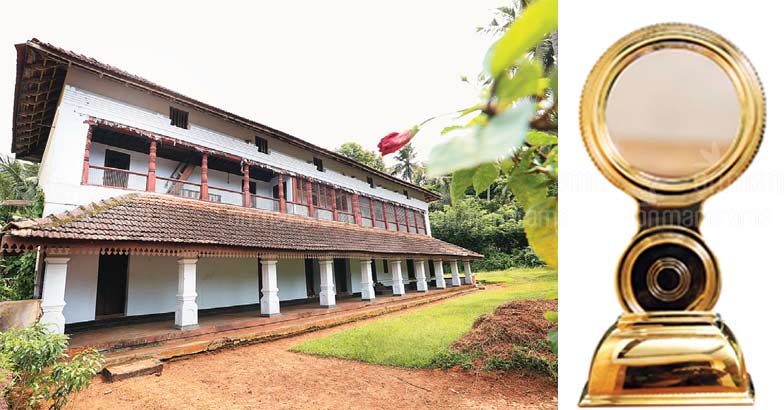
It’s four days of back-breaking work to craft a mirror. Nothing else but human hands can bring out the sheen of the mirror.
“View it as a task and the mirror will never shine,” says the craftsman. He cannot visualize giving a commercial angle to his trade by working out quick fixes. Krishnakumar’s brother Harigovindan is a sculptor who has to his credit countless statues worked to perfection, the St Alphonsa statue in Singapore’s Bun Lane being one among them.
“You need to know the structure of the human body just as a doctor if you need to get your statue right. The first to be set are the bones and the muscle. The face is what needs time. It has to be chiselled and polished. We take up to a year to sculpt a statue in bronze. We never think of the returns. It’s the beauty of the statue that we live for,” says Harigovind.
This purity of thought and deed is what makes Vellinezhi what it is and always will be.

